前面介绍了使用Android 编写OpenGL ES应用的程序框架,本篇介绍3D绘图的一些基本构成要素,最终将实现一个多边形的绘制。
一个3D图形通常是由一些小的基本元素(顶点,边,面,多边形)构成,每个基本元素都可以单独来操作。
Vertex (顶点)
顶点是3D建模时用到的最小构成元素,顶点定义为两条或是多条边交会的地方。在3D模型中一个顶点可以为多条边,面或是多边形所共享。一个顶点也可以代表一个点光源或是Camera的位置。下图中标识为黄色的点为一个顶点(Vertex)。
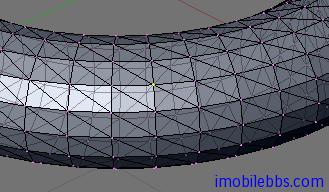 在Android系统中可以使用一个浮点数数组来定义一个顶点,浮点数数组通常放在一个Buffer(java.nio)中来提高性能。
在Android系统中可以使用一个浮点数数组来定义一个顶点,浮点数数组通常放在一个Buffer(java.nio)中来提高性能。
比如:下图中定义了四个顶点和对应的Android 顶点定义:
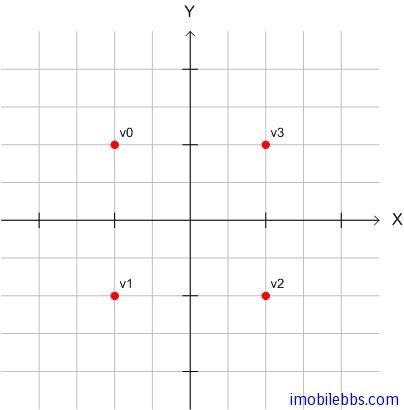
private float vertices[] = {
-1.0f, 1.0f, 0.0f, // 0, Top Left
-1.0f, -1.0f, 0.0f, // 1, Bottom Left
1.0f, -1.0f, 0.0f, // 2, Bottom Right
1.0f, 1.0f, 0.0f, // 3, Top Right
};
为了提高性能,通常将这些数组存放到java.io 中定义的Buffer类中:
// a float is 4 bytes, therefore we multiply the //number if vertices with 4. ByteBuffer vbb = ByteBuffer.allocateDirect(vertices.length * 4); vbb.order(ByteOrder.nativeOrder()); FloatBuffer vertexBuffer = vbb.asFloatBuffer(); vertexBuffer.put(vertices); vertexBuffer.position(0);
有了顶点的定义,下面一步就是如何将它们传给OpenGL ES库,OpenGL ES提供一个成为?管道Pipeline?的机制,这个管道定义了一些“开关”来控制OpenGL ES支持的某些功能,缺省情况这些功能是关闭的,如果需要使用OpenGL ES的这些功能,需要明确告知OpenGL “管道”打开所需功能。因此对于我们的这个示例,需要告诉OpenGL库打开 Vertex buffer以便传入顶点坐标Buffer。要注意的使用完某个功能之后,要关闭这个功能以免影响后续操作:
// Enabled the vertex buffer for writing and to be used during rendering. gl.glEnableClientState(GL10.GL_VERTEX_ARRAY);// OpenGL docs. // Specifies the location and data format of an array of vertex // coordinates to use when rendering. gl.glVertexPointer(3, GL10.GL_FLOAT, 0, vertexBuffer); // OpenGL docs. When you are done with the buffer don't forget to disable it. // Disable the vertices buffer. gl.glDisableClientState(GL10.GL_VERTEX_ARRAY);// OpenGL docs.
Edge(边)
边定义为两个顶点之间的线段。边是面和多边形的边界线。在3D模型中,边可以被相邻的两个面或是多边形形共享。对一个边做变换将影响边相接的所有顶点,面或多边形。在OpenGL中,通常无需直接来定义一个边,而是通过顶点定义一个面,从而由面定义了其所对应的三条边。可以通过修改边的两个顶点来更改一条边,下图黄色的线段代表一条边:
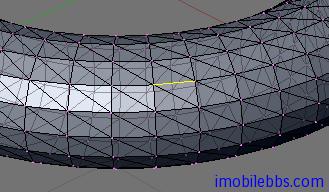
Face (面)
在OpenGL ES中,面特指一个三角形,由三个顶点和三条边构成,对一个面所做的变化影响到连接面的所有顶点和边,面多边形。下图黄色区域代表一个面。
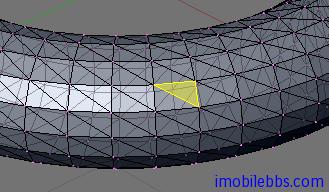 定义面的顶点的顺序很重要 在拼接曲面的时候,用来定义面的顶点的顺序非常重要,因为顶点的顺序定义了面的朝向(前向或是后向),为了获取绘制的高性能,一般情况不会绘制面的前面和后面,只绘制面的“前面”。虽然“前面”“后面”的定义可以应人而易,但一般为所有的“前面”定义统一的顶点顺序(顺时针或是逆时针方向)。
定义面的顶点的顺序很重要 在拼接曲面的时候,用来定义面的顶点的顺序非常重要,因为顶点的顺序定义了面的朝向(前向或是后向),为了获取绘制的高性能,一般情况不会绘制面的前面和后面,只绘制面的“前面”。虽然“前面”“后面”的定义可以应人而易,但一般为所有的“前面”定义统一的顶点顺序(顺时针或是逆时针方向)。
下面代码设置逆时针方法为面的“前面”:
gl.glFrontFace(GL10.GL_CCW);
打开 忽略“后面”设置:
gl.glEnable(GL10.GL_CULL_FACE);
明确指明“忽略“哪个面的代码如下:
gl.glCullFace(GL10.GL_BACK);
Polygon (多边形)
多边形由多个面(三角形)拼接而成,在三维空间上,多边形并一定表示这个Polygon在同一平面上。这里我们使用缺省的逆时针方向代表面的“前面Front),下图黄色区域为一个多边形。
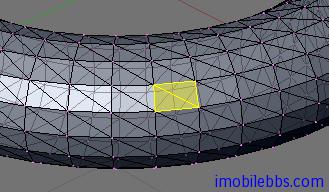 来看一个多边形的示例在Android系统如何使用顶点和buffer 来定义,如下图定义了一个正方形:
来看一个多边形的示例在Android系统如何使用顶点和buffer 来定义,如下图定义了一个正方形:
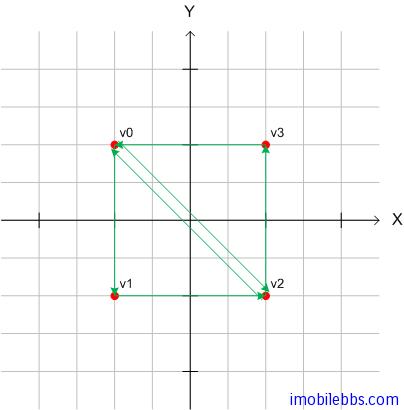 对应的顶点和buffer 定义代码:
对应的顶点和buffer 定义代码:
private short[] indices = { 0, 1, 2, 0, 2, 3 };
To gain some performance we also put this ones in a byte buffer.
// short is 2 bytes, therefore we multiply the number if vertices with 2.
ByteBuffer ibb = ByteBuffer.allocateDirect(indices.length * 2);
ibb.order(ByteOrder.nativeOrder());
ShortBuffer indexBuffer = ibb.asshortBuffer();
indexBuffer.put(indices);
indexBuffer.position(0);
Render (渲染)
我们已定义好了多边形,下面就要了解如和使用OpenGL ES的API来绘制(渲染)这个多边形了。OpenGL ES提供了两类方法来绘制一个空间几何图形:
- public abstract void glDrawArrays(int mode, int first, int count) 使用VetexBuffer 来绘制,顶点的顺序由vertexBuffer中的顺序指定。
- public abstract void glDrawElements(int mode, int count, int type, Buffer indices) ,可以重新定义顶点的顺序,顶点的顺序由indices Buffer 指定。
前面我们已定义里顶点数组,因此我们将采用glDrawElements 来绘制多边形。
同样的顶点,可以定义的几何图形可以有所不同,比如三个顶点,可以代表三个独立的点,也可以表示一个三角形,这就需要使用mode 来指明所需绘制的几何图形的基本类型。
GL_POINTS
绘制独立的点。
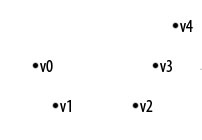
GL_LINE_STRIP
绘制一系列线段。
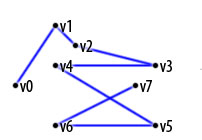
GL_LINE_LOOP
类同上,但是首尾相连,构成一个封闭曲线。
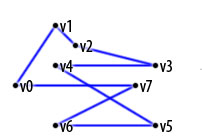
GL_LINES
顶点两两连接,为多条线段构成。

GL_TRIANGLES
每隔三个顶点构成一个三角形,为多个三角形组成。
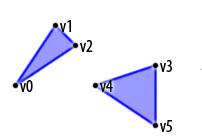 GL_TRIANGLE_STRIP
GL_TRIANGLE_STRIP
每相邻三个顶点组成一个三角形,为一系列相接三角形构成。
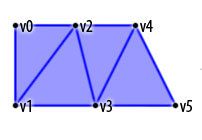
GL_TRIANGLE_FAN
以一个点为三角形公共顶点,组成一系列相邻的三角形。
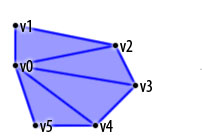
下面可以来绘制正方形了,在项目中添加一个Square.java 定义如下:
package se.jayway.opengl.tutorial;
import java.nio.ByteBuffer;
import java.nio.ByteOrder;
import java.nio.FloatBuffer;
import java.nio.ShortBuffer;
import javax.microedition.khronos.opengles.GL10;
public class Square {
// Our vertices.
private float vertices[] = {
-1.0f, 1.0f, 0.0f, // 0, Top Left
-1.0f, -1.0f, 0.0f, // 1, Bottom Left
1.0f, -1.0f, 0.0f, // 2, Bottom Right
1.0f, 1.0f, 0.0f, // 3, Top Right
};
// The order we like to connect them.
private short[] indices = { 0, 1, 2, 0, 2, 3 };
// Our vertex buffer.
private FloatBuffer vertexBuffer;
// Our index buffer.
private ShortBuffer indexBuffer;
public Square() {
// a float is 4 bytes, therefore we
// multiply the number if
// vertices with 4.
ByteBuffer vbb
= ByteBuffer.allocateDirect(vertices.length * 4);
vbb.order(ByteOrder.nativeOrder());
vertexBuffer = vbb.asFloatBuffer();
vertexBuffer.put(vertices);
vertexBuffer.position(0);
// short is 2 bytes, therefore we multiply
//the number if
// vertices with 2.
ByteBuffer ibb
= ByteBuffer.allocateDirect(indices.length * 2);
ibb.order(ByteOrder.nativeOrder());
indexBuffer = ibb.asShortBuffer();
indexBuffer.put(indices);
indexBuffer.position(0);
}
/**
* This function draws our square on screen.
* @param gl
*/
public void draw(GL10 gl) {
// Counter-clockwise winding.
gl.glFrontFace(GL10.GL_CCW);
// Enable face culling.
gl.glEnable(GL10.GL_CULL_FACE);
// What faces to remove with the face culling.
gl.glCullFace(GL10.GL_BACK);
// Enabled the vertices buffer for writing
//and to be used during
// rendering.
gl.glEnableClientState(GL10.GL_VERTEX_ARRAY);
// Specifies the location and data format of
//an array of vertex
// coordinates to use when rendering.
gl.glVertexPointer(3, GL10.GL_FLOAT, 0,
vertexBuffer);
gl.glDrawElements(GL10.GL_TRIANGLES, indices.length,
GL10.GL_UNSIGNED_SHORT, indexBuffer);
// Disable the vertices buffer.
gl.glDisableClientState(GL10.GL_VERTEX_ARRAY);
// Disable face culling.
gl.glDisable(GL10.GL_CULL_FACE);
}
}
在OpenGLRenderer 中添加Square成员变量并初始化:
// Initialize our square. Square square = new Square();
并在public void onDrawFrame(GL10 gl) 添加
// Draw our square. square.draw(gl);
来绘制这个正方形,编译运行,什么也没显示,这是为什么呢?这是因为OpenGL ES从当前位置开始渲染,缺省坐标为(0,0,0),和View port 的坐标一样,相当于把画面放在眼前,对应这种情况OpenGL不会渲染离view Port很近的画面,因此我们需要将画面向后退一点距离:
// Translates 4 units into the screen. gl.glTranslatef(0, 0, -4);
在编译运行,这次倒是有显示了,当正方形迅速后移直至看不见,这是因为每次调用onDrawFrame 时,每次都再向后移动4个单位,需要加上重置Matrix的代码。
// Replace the current matrix with the identity matrix gl.glLoadIdentity();
最终onDrawFrame的代码如下:
public void onDrawFrame(GL10 gl) {
// Clears the screen and depth buffer.
gl.glClear(GL10.GL_COLOR_BUFFER_BIT |
GL10.GL_DEPTH_BUFFER_BIT);
gl.glLoadIdentity();
gl.glTranslatef(0, 0, -4);
// Draw our square.
square.draw(gl); // ( NEW )
}
 本篇代码下载
本篇代码下载